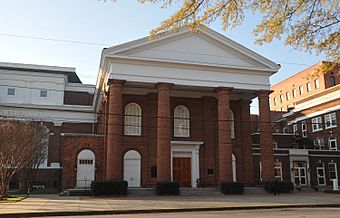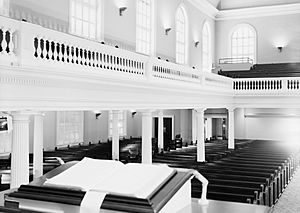First Baptist Church (Columbia, South Carolina) facts for kids
|
First Baptist Church
|
|

The Boyce Chapel in 2012
|
|
| Location | 1306 Hampton St., Columbia, South Carolina |
|---|---|
| Built | 1859 |
| Architectural style | Greek Revival |
| NRHP reference No. | 71000800 |
Quick facts for kids Significant dates |
|
| Added to NRHP | January 25, 1971 |
| Designated NHL | November 7, 1973 |
The James Petigru Boyce Chapel is a historic church building located at 1306 Hampton Street in Columbia, South Carolina. It's a beautiful building built in 1859, designed in the Greek Revival style.
A very important meeting happened here on December 17, 1860. Leaders from South Carolina voted to leave the United States, which helped start the American Civil War. Because of its historical importance, it was named a National Historic Landmark. At that time, it was known as the First Baptist Church. Today, this building is part of a larger church complex called First Baptist Church, Columbia. It's a very large Southern Baptist church.
Contents
A Look Back in Time
The First Baptist Church in Columbia started in 1809. Their first church building was built in 1811 on Sumter Street.
The second First Baptist Church building, which is the one we are talking about, was built in 1859. We don't know who designed it. A man named James P. Boyce paid for its construction. He used to be the president of the Southern Baptist Theological Seminary.
The Secession Convention
In 1860, this church became a very important place. After Abraham Lincoln was elected President of the United States, South Carolina decided to hold a meeting to discuss leaving the country. The church was chosen because it was the biggest meeting place in Columbia.
On December 17, 1860, under the leadership of D. F. Jamison, all 159 delegates voted "yes" to leave the United States. This vote was unanimous, meaning everyone agreed. South Carolina was the first state to secede, and it was the only state where the vote to secede was completely unanimous. Six other states followed South Carolina's lead before the Battle of Fort Sumter began.
This important meeting only lasted one day because there was an outbreak of smallpox in Columbia. The official document for South Carolina's secession was signed later, on December 20, when the delegates met again in Charleston, South Carolina. But it was at this little First Baptist Church in Columbia where South Carolina's leaders first declared their state would leave the Union.
Surviving the War
When the Union Army entered Columbia during the Civil War, they set fire to many buildings. They mistakenly burned the Washington Street Methodist Church, South, thinking it was the site of the secession meeting. A third of Columbia's buildings were burned, but the First Baptist Church was saved.
The Chapel Today
The original building was used for church services until 1992. These services were even shown on television! Since 1992, the main services have moved to a newer building connected to the historic one. This new building has a modern sanctuary and a family center. The original 1859 building was then renamed the Boyce Chapel, in honor of James P. Boyce.
Today, the Boyce Chapel is still used for many activities. It holds offices, weddings, and even has a coffee shop connected to it.
About the Building
The First Baptist Church building is designed in the Greek Revival style, which looks like ancient Greek temples. When it was first built, it was about 56 feet (17 m) wide and 84 feet (26 m) long. It has a grand entrance with columns, called a portico, and flat columns, called pilasters, along its sides. Inside, there are balconies on each side and above the entrance.
Around 1900, the bricks were painted a dull brown color. In 1941, the church got air conditioning, and the building was made longer by about 35 feet (11 m). This addition created space for the choir and a baptistery (a place for baptisms).
In 1949, fifteen-foot wide aisles were added to the sides. Steel columns, designed in the Doric style to match the old architecture, were put in to support the building. Also in 1949, the brown paint was removed from the brick walls. After the paint was gone, the walls showed colors ranging from dark pink to light tan.
The original church building from 1859 was 84 feet (26 m) deep and 56 feet (17 m) wide.
This historic building was added to the National Register of Historic Places in 1971. It became a National Historic Landmark in 1973, recognizing its great importance to American history.
See also




